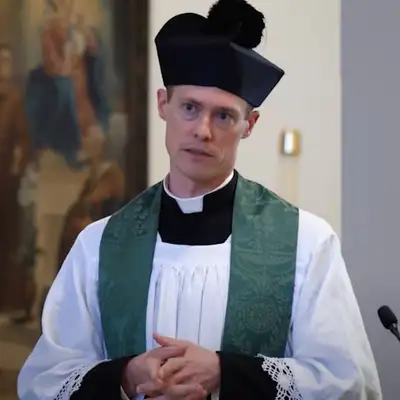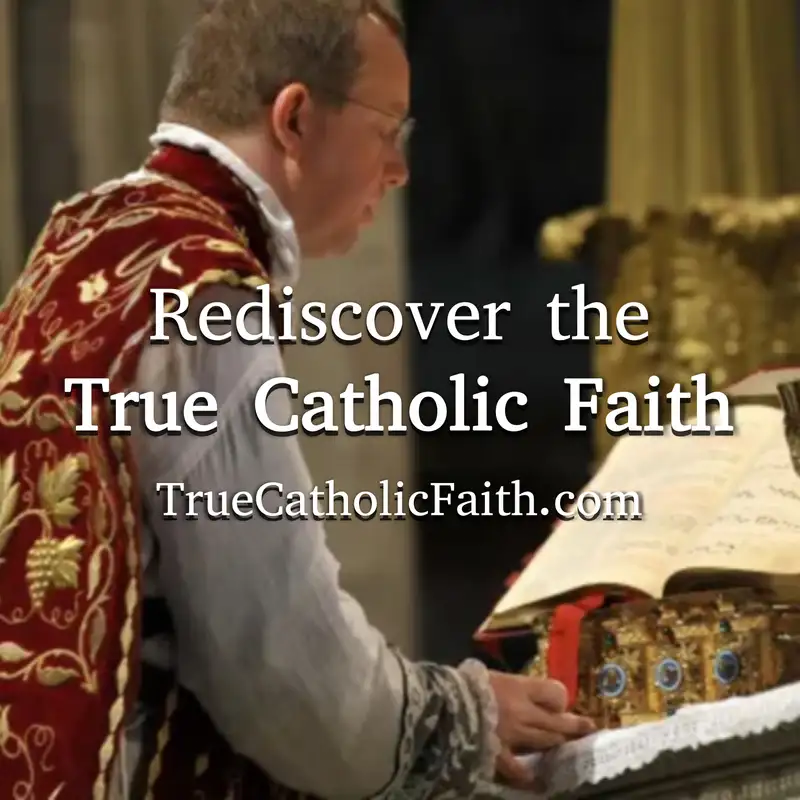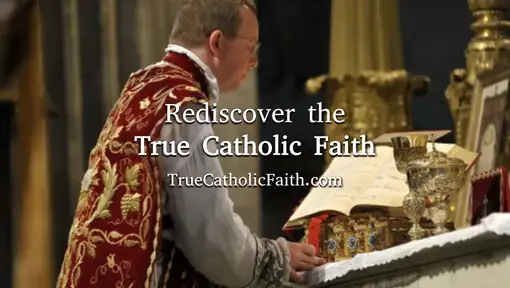The Lies of Ratzinger - Fr. Michael DeSaye 06-30-24
Download MP3In the name of the father and of the son and of the holy ghost. Amen.
Fr. Michael DeSaye:There is a lot of talk now about further suppressions of the traditional mass which are to take place at some point in the near future. The Vatican is apparently concerned that people who go to the traditional mass are forming a kind of cult against Vatican II, against the Novus Ordo, and against the authority of Bergoglio. The word for this in moral theology is sedition.
Fr. Michael DeSaye:This means acts which, while not explicitly schismatic, are nevertheless directed toward a revolution or schism, which foster schism. Now the Vatican's attitude toward this is correct. That is exactly what is happening in these traditional mass groups in diocesan parishes. But the Internet theologians who have made themselves the spokesman of this cause are loudly protesting that this is not the case. They are saying that they accept Vatican two, they accept the Novus Ordo, and they submit to the authority of Bergoglio.
Fr. Michael DeSaye:These are not true. In truth, they do not accept Vatican II. They despise the Novus Ordo, and they do not accept the authority of Bergoglio. I speak from experience. When I was in the Novus Ordo, I had a great deal of interaction with these traditional mass people in several different dioceses, and it is the same everywhere.
Fr. Michael DeSaye:They are practically sedevacantists in everything but name. So why are they suddenly pretending to have a great devotion to Vatican II? Well, it is purely in order to try to convince their hierarchy that they are submissive, docile Novus Ordites so that their traditional mass might not get canceled. It seems, however, that the Vatican is not going to be fooled by this game. The man at the Vatican cannot be fooled.
Fr. Michael DeSaye:They are expert liars. They have dedicated their entire lives to a lie, the lie that they are Catholic. They know exactly what it is to pretend to be in a different religion. That is exactly what they have been doing for decades. So it seems that those who attend the traditional mass in diocesan parishes will be powerless to stop them.
Fr. Michael DeSaye:How did things get to this point? In this sermon, I am going to try to answer that question with some brief history. What we might legitimately call the first Novus Ordo Mass was celebrated in 1922, just after World War one at a church near Vienna, Austria. It was celebrated by an Augustinian priest named Father Pius Parsh. He called this mass the people's mass or the folks' mass, and it had all the hallmarks of what would later become the Novus Ordo.
Fr. Michael DeSaye:The priest wore large flowing vestments called Gothic vestments. He faced the people at mass instead of the cross. He used a portable table instead of an altar. Many of the prayers were in German instead of Latin. A layman read the epistle and other prayers in German.
Fr. Michael DeSaye:The music for Mass was in German and composed in a contemporary pop style with folk instruments and sung by a local folk musician. The congregation was encouraged to sing along. The people brought up the bread and the wine in a procession down the central aisle of the church and handed them to the priest. At the pox, the people all turned to one another and shook hands in an awkward and noisy manner. The priest advertised this strange mass as an experiment intended to challenge preexisting ideas and foster discussion about possible reform of the mass.
Fr. Michael DeSaye:Now this is not how things work in the Catholic church. Parish priests are not allowed to use the sanctuaries of their churches as if they were their own personal laboratories for conducting experiments. Yet this priest who did so was not punished by his superior. In fact, he was encouraged to share this experimental mass with other priests. As a result, the people's mass began to spread and within a few years it could be found all over Austria, as well as Germany, France and Belgium.
Fr. Michael DeSaye:It was not adopted strictly as it was initially celebrated in all places, but rather the main aspects were taken as a kind of loose template or suggestion or springboard for even more radical experiments according to the taste of the individual priest celebrant. The basics, however, could be found everywhere. Gothic vestments, table altars, priests facing the people, use of vernacular instead of Latin, congregational singing, pop music, noisy handshaking, and late processions carrying bread and wine. The people's mass became a symbol of dissent, rebellion, and protest among leftist priests and like minded laity. The standards of dress for the laity at this mass began to erode.
Fr. Michael DeSaye:Veils disappeared. Women came to church showing off trendy new hairdos and worldly fashions. Even the dress of priests changed. Cinctures disappeared. Manipoles disappeared. Amises and beretta's disappeared.
Fr. Michael DeSaye:Priests stopped wearing the cassock in favor of just a suit. The whole experience was like a protester's sign held high up in the air saying the church must change everything now and adapt to the world. Everyone who was anxious to see major changes in teachings, morals, and worship gravitated to this new mass as if it were their banner. Now at that time, before Vatican two, this new mass was offered at a separate time than the traditional mass and presented as an option or an alternative to the traditional mass in the same church.
Fr. Michael DeSaye:Thus, on a given Sunday, one could either attend the traditional mass where there were two servers that said the responses just like we have here, or they could go to this alternative new mass, this new liberal mass. Now the result of these two masses was that there was a division in the parishes. Liberal parishioners liked the new mass and traditional parishioners liked the old mass. Thus, priests found themselves having to minister to two distinct groups of people, the traditional group and the new menace group. And the two groups didn't get along and they did not see eye to eye on anything.
Fr. Michael DeSaye:In fact, the situation was so intolerable that bishops of these countries began to receive many complaints. But the bishops did very little. In fact, by the nineteen fifties, many of them even embraced the new mass and celebrated it themselves, identifying themselves with its symbolic call to change the church. In the nineteen sixties, the experimental mass movement received the support of both John XXIII and Paul VI , both of whom issued reforms which furthered the aims of this movement. Finally, in 1969, Paul VI promulgated the final edition of the new Mass which we know today as the Novus Ordo.
Fr. Michael DeSaye:It was largely inspired by the People's Mass, but with many additional modifications, taking a great deal of its inspiration from Eastern schismatics, Lutheranism, Anglicanism, and Judaism. The Novus Ordo shocked everyone at the time, and the idea began to spread that perhaps Paul VI had been deceived by conspirators in the Vatican. It seemed like the only way to explain how something so obviously spiritually harmful could come from the supreme shepherd of souls. Decent Catholics felt as though they should give him the benefit of the doubt. When the nova sorto became public in 1969, it was brought to the attention of a Roman noblewoman who was deeply concerned that this new mass was a substantial departure from the traditional Catholic mass.
Fr. Michael DeSaye:In other words, she perceived it to be a non Catholic Mass. Gravely worried that the Catholic Mass was in danger of disappearing, she appealed to a group of Roman theologians, teachers at a series of Roman universities, to do a study of the Novusorum to see if her premonitions were correct. The result was a work entitled Brief Critical Examination of the Novus Ordo Missae, principally written by father Guérard des Lauriers , but later known as the Ottaviani intervention because Cardinal Ottaviani attached his signature to the document. The document concludes that the novus ordo was, and I quote, a most serious deviation from the theology of the Catholic Mass, a destruction of the unity of worship and the unity of faith, a violent blow to belief in the real presence of Christ in the Blessed Sacrament, a debasement of the Church, a tragic compromise of the Church's unity, a sign of division teeming with errors against the integrity of the Catholic religion, and pleasing only those who are hovering on the verge of apostasy. The document also said that the modus significandi of the words of consecration were substantially altered.
Fr. Michael DeSaye:What does that mean? This was a technical way of implying that the new mass was not even a true mass at all. The documents said that if the nova sorto were not abrogated, the Catholic faithful would have to make a very difficult choice. Now it doesn't spell out exactly what that choice would be, but the implication was clear. The faithful would either have to accept the Novus Ordo and abandon the Catholic religion, or reject the Novus Ordo and abandon Giovanni Battista Montini, Paul VI , and his ministers as false shepherds.
Fr. Michael DeSaye:The authors of the document asked for an outright abrogation of the nova sorda and for a reinstitution of the traditional menace. In response, Montini fired the authors of the document from their teaching positions in their schools in Rome, and he did not respond to any of their criticisms. He universally forbade the celebration of the traditional Mass, treating it as if it were a crime punishable by censures. Priests who wished to celebrate it had to do so secretly outside of churches, and those who were caught doing so were either forced into an early retirement or censured. Clearly, he did not promulgate the novus ordo by accident, as if he were an innocent and simple man who was deceived by conspirators in the Vatican.
Fr. Michael DeSaye:He knew exactly what he was doing when he promulgated the novus ordo. In fact, he had been a passionate admirer of the novus ordo as far back as the 1920's when it was still the people's mass. Today, there is still an idea floating around that Paul VI never abrogated the traditional mass. This is absolutely false. He abrogated it explicitly in the Novus Ordo Missae in very precise legal terms.
Fr. Michael DeSaye:You can open the Novus Ordo Missae and read it yourself. He also abrogated it in practice by hunting down and punishing anyone who celebrated it. It was Ratzinger who fictionalized this history. Ratzinger always believed that the Novus Ordo was good, But he thought that the way that it was introduced was too abrupt, too swift. He believed that the mass needed to evolve and change and be reformed, but he thought that it should be done gradually instead of suddenly.
Fr. Michael DeSaye:And so he had a sympathy for those who preferred the traditional not because he liked it, in fact he despised it, but because he believed that the transition from traditional mass to Novus Ordo was too fast. He felt everyone should have been allowed more time to acclimate to the Novus Ordo. This was the main reason why the FSSP and Institute of Christ the King were created, to comfort that older generation who still had strong feelings for the traditional Mass to smooth over the transition to the Novus Ordo. It was like a pastoral concession granted by John Paul II at that time to those who, in his words, were attached to the older forms. He was treating the traditional mass as if it were like an old fashioned flavor of ice cream that older people liked because they grew up with that flavor.
Fr. Michael DeSaye:But now the company has decided to discontinue that flavor because it will not sell very well, and they're going to just create a kind of period of time where they will continue to sell it with the idea that it will eventually go out of style. He describes this is John Paul II. He describes the traditional Mass as their tradition, as if it were nothing more than a sort of regional piety that he agreed to tolerate. This was the same reason why Ratzinger introduced Summorum Pontificum in February 2007. To comfort that older generation who had a nostalgia for the traditional Mass.
Fr. Michael DeSaye:This was what he meant when he said that he wanted to effect a reconciliation in the heart of the church. He said, what earlier generations held as sacred remains sacred and great for us too. It cannot be all of a sudden entirely forbidden or even considered harmful. You have to understand that he is a modernist. For him, the mass is nothing more than an expression of inner impulses or feelings.
Fr. Michael DeSaye:It is the outward expression of interior sentiments and nothing more. And so if a certain collective of people have the same sentiments with regard to the mass, they should not be denied according to Ratzinger their opportunity to express their interior feelings in the traditional ness if it suits them. But that is all. So Ratzinger made up the idea that the traditional ness was never abrogated out of an attempt to reassure people that they were not doing anything wrong back in the 1970s when they were attending the traditional mass in hotel lobbies and in rented halls, comforting people by lying to them. That is Ratzinger.
Fr. Michael DeSaye:Ratzinger also insisted that the Novus Ordo was holy and that no priest can refuse to celebrate it on a matter of principle. Ratzinger never intended the traditional mass to become a worldwide movement drawing people away from the Novus Ordo or away from Vatican II, but that is precisely what the results of Summorum Pontificum have been for the past seventeen years. People are rejecting the Novus Ordo Mass on a matter of principle, and not only the Mass, but also Novus Ordo canonizations, Novus Ordo feast days, Novus Ordo piety, catechisms and morality. The existence of the traditional Mass in parishes is creating a de facto schism within parishes throughout the world, and Bergoglio sees this all too clearly, hence why he wishes to overturn the motu proprio. The truth, of course, is that the traditional Mass can never exist peacefully alongside the novus ordo any more than Christ can exist peacefully alongside Satan.
Fr. Michael DeSaye:The two are mutually opposed, and always will be. He who wishes to live true to his Catholic faith must, on principle, reject the Novus Ordo as something evil, and must avoid all ministers who celebrate it and all ministers who are in union with them as scandalous promoters of evil in the world. Now if the traditional mass is restricted, as seems likely, the SSPX are going to tell everyone to come to them instead of the sedevacantists because they will say, they are in communion with Rome. This is absurd. They are not in communion with Rome, but rather they are at war with Rome, exercising a worldwide apostolate totally independent from Rome, and they admit this.
Fr. Michael DeSaye:It is impossible to be fighting against someone and in communion with them at the same time. So they also show themselves to be liars on an institutional scare. The only correct route to take is to entirely separate oneself from that association of wicked men who continue to operate the deception of Vatican II, and to go where there is no deception, but truth in worship, in doctrine, and in morality, To go where there is no ambiguity, no lies, no subversion, no plots, no secret revolutions, but clarity of teaching and correct pastoral application of Catholic moral principles. I used to think that such a place did not exist, but I was wrong. It does exist, and it is here.
Fr. Michael DeSaye:In the name of the Father, and of the Son, and of the Holy Ghost. Amen.
Creators and Guests


